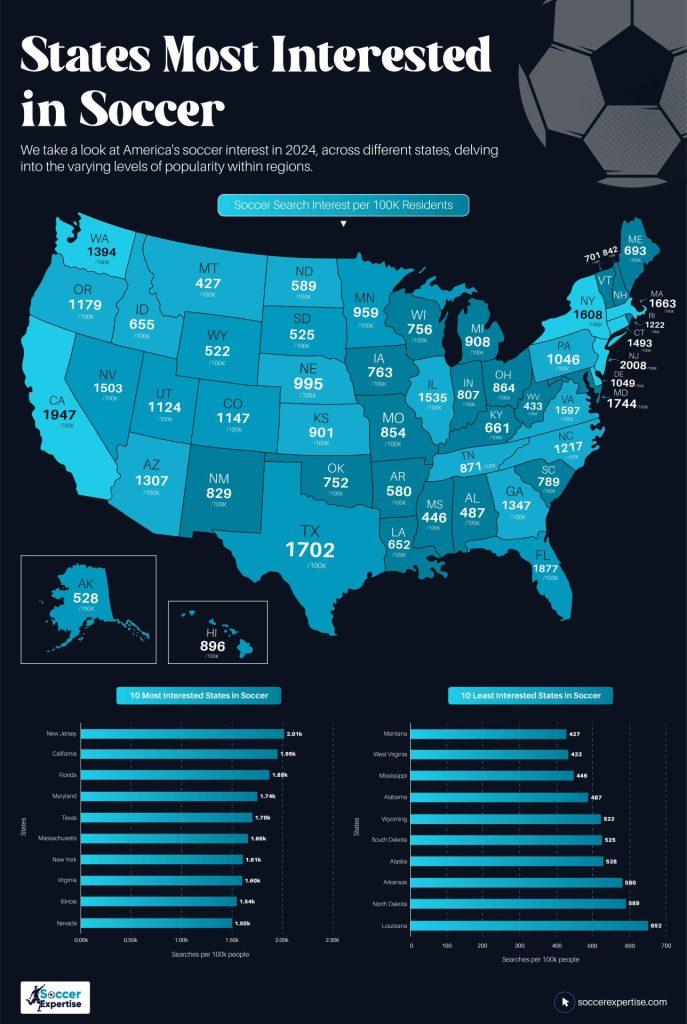Exploring the Rise of Soccer Fandom and Participation Across the United States
Top States Driving Soccer Enthusiasm and Involvement
Soccer’s momentum in the U.S. is unmistakable, with certain states standing out as epicenters of the sport’s expanding popularity. Leading the charge are California and Texas, which consistently report the highest levels of both player participation and fan engagement nationwide. California’s multicultural population combined with extensive youth soccer programs creates a vibrant soccer culture. Texas, meanwhile, benefits from a rich mix of immigrant communities and the rise of professional teams that attract large crowds. Other states like Washington and Colorado have also experienced significant surges in soccer interest, thanks in part to Major League Soccer (MLS) expansions and hosting international competitions.
The passion for soccer in these regions is evident through several key indicators:
- Youth Participation: Soccer ranks as the leading sport among children, signaling a strong pipeline for future talent.
- Game Attendance: MLS and USL matches frequently reach near or full capacity, with season tickets often sold out well in advance.
- Media Presence: Increased airtime on local sports networks and dedicated soccer shows reflect growing public interest.
| State | Youth Soccer Participation Rate | Average MLS Stadium Attendance | Soccer Media Coverage Level |
|---|---|---|---|
| California | 29% | 96% | Extensive |
| Texas | 25% | 91% | Extensive |
| Washington | 23% | 88% | Moderate |
| Colorado | 21% | 86% | Moderate |
Regional Influences Shaping Soccer’s Growth Across America
The increasing enthusiasm for soccer in the U.S. is deeply influenced by regional characteristics such as demographics, climate, and the presence of professional teams. In states like California and Texas, the sport has been embraced by diverse immigrant populations, embedding soccer into the local culture. Favorable weather conditions in these areas allow for longer playing seasons, which supports thriving youth leagues and community programs. The success of teams like LA Galaxy and FC Dallas has further galvanized fan loyalty, boosting attendance and media attention.
Meanwhile, northeastern and midwestern states are witnessing a rise in soccer interest driven by historic collegiate programs and the emergence of MLS franchises such as New York City FC and Chicago Fire FC. Urban hubs with active soccer communities often experience heightened online engagement and merchandise sales, underscoring the sport’s economic impact. Key factors influencing regional variations include:
- Ethnic and cultural diversity fostering broad-based fan and player participation
- Accessibility to professional and semi-professional clubs encouraging local support
- Investment in soccer facilities and youth academies enhancing player development
| Region | Leading State for Soccer Interest | Primary Growth Drivers |
|---|---|---|
| West Coast | California | Cultural diversity and favorable climate |
| South | Texas | Professional clubs and youth soccer investments |
| Northeast | New York | MLS franchises and urban soccer culture |
| Midwest | Illinois | Strong college soccer traditions and club expansion |
How Soccer’s Popularity Benefits Communities and Youth Development
Soccer’s growing appeal is transforming communities nationwide, fostering a sense of unity and cultural exchange that extends well beyond the game itself. In many areas, soccer has become a cornerstone of community identity, bringing together people from diverse backgrounds through local leagues, tournaments, and grassroots programs. The sport’s accessibility makes it an ideal activity for youth, promoting physical health, teamwork, and social skills. Communities with strong soccer followings often see increased funding for sports facilities and youth development initiatives, creating a nurturing environment for aspiring players.
The positive effects of soccer engagement on young people include:
- Improved Physical Fitness: Regular participation helps combat childhood obesity and encourages healthy lifestyles.
- Academic Benefits: Studies link sports involvement with better school attendance and academic achievement.
- Social and Emotional Growth: Team sports like soccer develop leadership, communication, and resilience.
- Opportunities for Advancement: Talented youth can access scholarships, elite training, and international exposure.
| State | Youth Soccer Participation Rate | Number of Community Soccer Programs |
|---|---|---|
| California | 29% | 460+ |
| Texas | 25% | 360+ |
| Florida | 23% | 310+ |
| Washington | 21% | 280+ |
| Colorado | 19% | 230+ |
Effective Approaches to Boost Soccer Engagement in Emerging Regions
The rapid growth of soccer in emerging U.S. markets is driven by a combination of grassroots efforts and innovative media strategies. Youth development initiatives play a crucial role, partnering with schools and local clubs to introduce soccer to children, especially in areas where the sport has historically had less presence. These programs prioritize inclusivity and affordability, often collaborating with community organizations and businesses to provide necessary resources like equipment and fields, making soccer accessible to a broad demographic.
Additionally, digital platforms and targeted broadcasting have revolutionized how fans in less traditional soccer markets engage with the sport. Streaming services allow supporters to watch MLS games and international tournaments live, fostering a stronger connection to soccer. Key tactics fueling this growth include:
- Region-specific content that respects local languages and cultural preferences
- Interactive fan engagement, including virtual viewing parties and online discussion groups
- Collaborations with ethnic media outlets to reach diverse audiences
- Social media campaigns leveraging influencers and players to create relatable stories
Summary: The Expanding Footprint of Soccer in America
As soccer continues its upward trajectory in the United States, identifying the states with the most fervent interest provides valuable insight into the sport’s evolving landscape. From established soccer strongholds to rapidly growing new markets, the diversity of American soccer fandom is broadening. Ongoing monitoring of these trends will reveal how soccer continues to influence community identity, youth development, and cultural integration nationwide.







